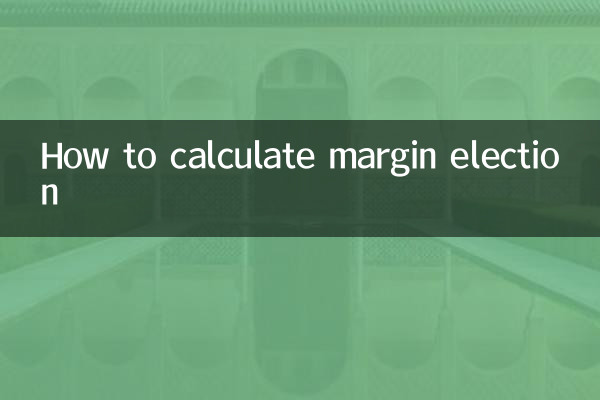How to calculate margin election
Differential election is a common election method. Unlike equal election, it requires more candidates than the number of candidates to be elected, thus providing voters with more choices. In recent years, differential elections have been widely used in politics, businesses and social organizations, and have become one of the hot topics. This article will introduce the calculation method of differential election in detail, and combine it with structured data to help readers better understand.
1. Basic concepts of differential election

The core of the differential election lies in the "margin", that is, the number of candidates is more than the number of candidates. For example, if 5 people need to be selected for a certain position, but there are 8 candidates, the difference is 3 people. This election method can stimulate competition and improve the fairness and transparency of elections.
2. Calculation method of margin election
The calculation of the margin election mainly involves the following steps:
1.Determine the number of candidates and number of candidates: First, clarify the number of positions to be selected (number of candidates) and the number of candidates competing.
2.Calculate the difference ratio: The difference ratio is the ratio of the difference between the number of candidates and the number of candidates to the number of candidates. The calculation formula is as follows:
| project | Calculation formula | Example |
|---|---|---|
| Difference ratio | (Number of candidates - Number of candidates) / Number of candidates × 100% | If 5 people should be selected and 8 candidates are selected, the difference ratio is (8-5)/5×100%=60% |
3.Voting and counting: Voters vote according to rules, usually using the rule of "highest to lowest number of votes" to determine the elected candidate.
4.Result confirmation: After counting the votes, the top N candidates with the highest votes will be elected (N is the number of candidates).
3. Advantages and disadvantages of differential election
The advantage of differential election is that it can reflect democratic competition, but it also has some limitations. Here is a structured comparison:
| advantage | shortcoming |
|---|---|
| Make elections more competitive | Votes may be scattered due to too many candidates |
| Provide voters with more choices | The vote counting process is relatively complicated |
| Increase electoral transparency | Requires more organizational costs |
4. Practical application cases of differential election
In recent years, differential elections have been used in many fields. The following are popular cases in the past 10 days:
| field | Case | Difference ratio |
|---|---|---|
| political election | In the election of deputies to the People’s Congress of a certain city, there are 10 candidates to be elected and 15 candidates. | 50% |
| corporate board of directors | In the election of the board of directors of a listed company, there are 7 candidates to be elected and 10 candidates. | 42.9% |
| social organization | A public welfare organization's board of directors election, 5 people should be elected and 8 candidates | 60% |
5. How to optimize margin election
In order to give full play to the advantages of differential elections, the following measures can be taken:
1.Reasonably set the balance ratio: If the balance ratio is too high, it may lead to low election efficiency; if it is too low, it will be difficult to reflect competitiveness. It is recommended to control it between 20% and 50%.
2.Strengthen candidate publicity: Let voters know the candidates’ backgrounds and propositions through multiple channels to improve the quality of elections.
3.Simplify the vote counting process: Use electronic vote counting system or third-party supervision to ensure fair and transparent results.
Conclusion
Comparison election is an important form of democratic election, and its calculation method and application scenarios deserve in-depth discussion. Through the structured analysis of this article, we hope that readers can more clearly understand the operating mechanism of differential elections and apply it flexibly in practice.

check the details

check the details